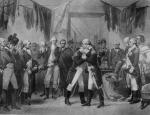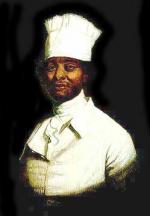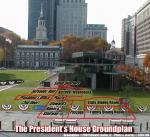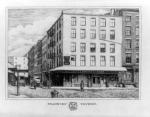![header=[Marker Text] body=[Here stood Fraunces Tavern established by Samuel Fraunces after moving from New York where he had operated a famous tavern. He served as George Washington's chief cook, 1790-94, while the president lived in Philadelphia.] sign](http://explorepahistory.com/kora/files/1/10/1-A-28A-139-ExplorePAHistory-a0h9e1-a_450.jpg)
Mouse over for marker text
Name:
Fraunces Tavern
Region:
Philadelphia and its Countryside/Lehigh Valley
County:
Philadelphia
Marker Location:
310 S. 2nd St., Philadelphia
Behind the Marker
When the nation's capital moved from New York City to Philadelphia in 1790, President George Washington set up his presidential quarters in  Robert Morris's mansion just a block from the Philadelphia State House on Market Street. Washington then had the mansion enlarged to accommodate a household of thirty people, which included his wife and her grandchildren, three male secretaries, fifteen white servants - and eight enslaved African Americans from his Mount Vernon plantation. Presiding as steward over this staff was the Caribbean-born Samuel "Black Sam" Fraunces, the celebrated New York restaurant owner and chef, who had known Washington since the early years of the Revolutionary War.
Robert Morris's mansion just a block from the Philadelphia State House on Market Street. Washington then had the mansion enlarged to accommodate a household of thirty people, which included his wife and her grandchildren, three male secretaries, fifteen white servants - and eight enslaved African Americans from his Mount Vernon plantation. Presiding as steward over this staff was the Caribbean-born Samuel "Black Sam" Fraunces, the celebrated New York restaurant owner and chef, who had known Washington since the early years of the Revolutionary War.
Born of African and European parentage in 1722, Fraunces had moved to New York City in the 1750s, where he became proprietor of a series of highly successful inns. In 1762 he opened Fraunces Tavern at Pearl Street and Broadway, a popular restaurant known for its excellent cuisine and fine wines, which in the 1770s became the gathering place for the New York Sons of Liberty and other supporters of Independence. During the American Revolution, Fraunces used his position as a cook for the British to spy for the Americans and in other ways supported the struggle for independence. After the British left New York, his tavern became a favorite stop for George Washington, who in the tavern's Long Room bade farewell to his officers when he retired in December, 1783.
After Washington was inaugurated as the nation's first president in 1789, Fraunces became steward of the President's house in New York. When the capital moved to Philadelphia in 1790, Fraunces followed. In 1780, Pennsylvania had passed the nation's first abolition law, but it provided only for the gradual emancipation of slaves. The law also restricted people from other states from bringing their own slaves into the state except for brief periods.
abolition law, but it provided only for the gradual emancipation of slaves. The law also restricted people from other states from bringing their own slaves into the state except for brief periods.
Under this exemption, Washington kept seven slaves in his Presidential mansion. To comply with Pennsylvania law, he made sure to return his eight enslaved men and women to his plantation in Virginia at least once every six months. This did not, however, prevent two of his slave staff, Oney Judge and Hercules, from running away to freedom. Confronted by unwanted publicity and personally opposed to slavery, Washington eventually replaced his enslaved black workers with indentured servants from Germany and arranged for all his slaves to be freed when his wife Martha died.
Fraunces managed the presidential household there from 1791 to 1794. While still in Washington's service, he opened a new restaurant near this marker on Second Street. In 1793, he relocated the restaurant, now named "The Golden Tun Tavern," to south Water Street. On October 12, 1795, Fraunces died at the age of seventy-two.
After the national capital moved from Philadelphia to Washington, District of Columbia, in 1800, the Philadelphia President's House fell into disrepair. In 1832 it was gutted and then forgotten-along with President Washington's slaves. In 1951 the last remaining wall was demolished during the creation of Independence Mall.
In 2002, historian Edward Lawler's rediscovery that President Washington had kept African American slaves only a block from Independence Hall-and only a few feet from the new pavilion built to house the Liberty Bell- triggered a public outcry for commemoration. In the aftermath, African-American community groups, historians, political leaders, and others pressured the National Park Service into revising its planned interpretation for the new Liberty Bell Center to include acknowledgement and interpretation of the lives of the enslaved African Americans who had worked and lived in President Washington's household between 1790 and 1797.
Much about Fraunces' own life remains a mystery, in no small part because of the complexities of race in the early years of American independence. In the new United States, "Black Sam" Fraunces often passed as white, as did some of his children, but not others. This fact and contradictory records led to disagreement among historians about his racial identity. At the time of his baptism in Jamaica, Samuel was listed as a mulatto, but the 1790 United States Census, often unreliable on its recording of race, lists him as a free, white head-of-household with four females and one slave at his address.
In New York, Fraunces was registered to vote–a privilege only available to whites–and attended a white church, and his wife was white. His son, however, also named Samuel, was always listed and recalled as negro, as was his daughter Sophia. A bon vivant, whose friends included prominent citizens in New York and Philadelphia, Fraunces left little record of his own life or thoughts. Today, a reconstruction of his New York City Tavern is a museum run by the Sons of the Revolution in the State of New York. Further confusion arises from a painting, purportedly of Fraunces, that hangs on a wall in the tavern. Samuel Fraunces is buried in an unmarked grave at St. Peter's Church in Philadelphia.
Born of African and European parentage in 1722, Fraunces had moved to New York City in the 1750s, where he became proprietor of a series of highly successful inns. In 1762 he opened Fraunces Tavern at Pearl Street and Broadway, a popular restaurant known for its excellent cuisine and fine wines, which in the 1770s became the gathering place for the New York Sons of Liberty and other supporters of Independence. During the American Revolution, Fraunces used his position as a cook for the British to spy for the Americans and in other ways supported the struggle for independence. After the British left New York, his tavern became a favorite stop for George Washington, who in the tavern's Long Room bade farewell to his officers when he retired in December, 1783.
After Washington was inaugurated as the nation's first president in 1789, Fraunces became steward of the President's house in New York. When the capital moved to Philadelphia in 1790, Fraunces followed. In 1780, Pennsylvania had passed the nation's first
Under this exemption, Washington kept seven slaves in his Presidential mansion. To comply with Pennsylvania law, he made sure to return his eight enslaved men and women to his plantation in Virginia at least once every six months. This did not, however, prevent two of his slave staff, Oney Judge and Hercules, from running away to freedom. Confronted by unwanted publicity and personally opposed to slavery, Washington eventually replaced his enslaved black workers with indentured servants from Germany and arranged for all his slaves to be freed when his wife Martha died.
Fraunces managed the presidential household there from 1791 to 1794. While still in Washington's service, he opened a new restaurant near this marker on Second Street. In 1793, he relocated the restaurant, now named "The Golden Tun Tavern," to south Water Street. On October 12, 1795, Fraunces died at the age of seventy-two.
After the national capital moved from Philadelphia to Washington, District of Columbia, in 1800, the Philadelphia President's House fell into disrepair. In 1832 it was gutted and then forgotten-along with President Washington's slaves. In 1951 the last remaining wall was demolished during the creation of Independence Mall.
In 2002, historian Edward Lawler's rediscovery that President Washington had kept African American slaves only a block from Independence Hall-and only a few feet from the new pavilion built to house the Liberty Bell- triggered a public outcry for commemoration. In the aftermath, African-American community groups, historians, political leaders, and others pressured the National Park Service into revising its planned interpretation for the new Liberty Bell Center to include acknowledgement and interpretation of the lives of the enslaved African Americans who had worked and lived in President Washington's household between 1790 and 1797.
Much about Fraunces' own life remains a mystery, in no small part because of the complexities of race in the early years of American independence. In the new United States, "Black Sam" Fraunces often passed as white, as did some of his children, but not others. This fact and contradictory records led to disagreement among historians about his racial identity. At the time of his baptism in Jamaica, Samuel was listed as a mulatto, but the 1790 United States Census, often unreliable on its recording of race, lists him as a free, white head-of-household with four females and one slave at his address.
In New York, Fraunces was registered to vote–a privilege only available to whites–and attended a white church, and his wife was white. His son, however, also named Samuel, was always listed and recalled as negro, as was his daughter Sophia. A bon vivant, whose friends included prominent citizens in New York and Philadelphia, Fraunces left little record of his own life or thoughts. Today, a reconstruction of his New York City Tavern is a museum run by the Sons of the Revolution in the State of New York. Further confusion arises from a painting, purportedly of Fraunces, that hangs on a wall in the tavern. Samuel Fraunces is buried in an unmarked grave at St. Peter's Church in Philadelphia.
Beyond the Marker









